

How we did this
Pew Research Center has long studied the changing nature of romantic relationships and the role of digital technology in how people meet potential partners and navigate web-based dating platforms. This particular report focuses on the patterns, experiences and attitudes related to online dating in America. These findings are based on a survey conducted Oct. 16 to 28, 2019, among 4,860 U.S. adults. This includes those who took part as members of Pew Research Center’s American Trends Panel (ATP), an online survey panel that is recruited through national, random sampling of residential addresses, as well as respondents from the Ipsos KnowledgePanel who indicated that they identify as lesbian, gay or bisexual (LGB). The margin of sampling error for the full sample is plus or minus 2.1 percentage points.
Recruiting ATP panelists by phone or mail ensures that nearly all U.S. adults have a chance of selection. This gives us confidence that any sample can represent the whole U.S. adult population (see our Methods 101 explainer on random sampling). To further ensure that each ATP survey reflects a balanced cross-section of the nation, the data are weighted to match the U.S. adult population by gender, race, ethnicity, partisan affiliation, education and other categories.
For more, see the report’s methodology about the project. You can also find the questions asked, and the answers the public provided in this topline.
From personal ads that began appearing in publications around the 1700s to videocassette dating services that sprang up decades ago, the platforms people use to seek out romantic partners have evolved throughout history. This evolution has continued with the rise of online dating sites and mobile apps.
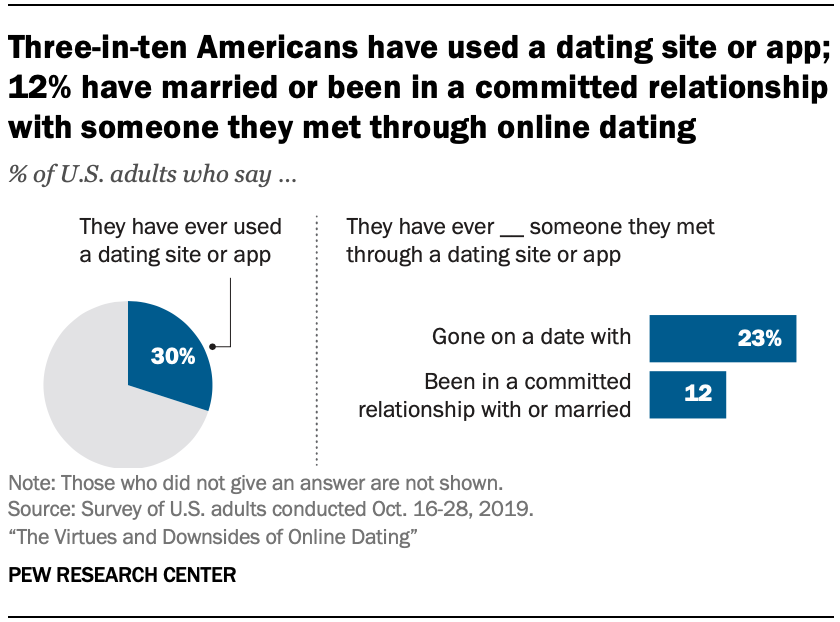
Today, three-in-ten U.S. adults say they have ever used an online dating site or app – including 11% who have done so in the past year, according to a new Pew Research Center survey conducted Oct. 16 to 28, 2019. For some Americans, these platforms have been instrumental in forging meaningful connections: 12% say they have married or been in a committed relationship with someone they first met through a dating site or app. All in all, about a quarter of Americans (23%) say they have ever gone on a date with someone they first met through a dating site or app.
Previous Pew Research Center studies about online dating indicate that the share of Americans who have used these platforms – as well as the share who have found a spouse or partner through them – has risen over time. In 2013, 11% of U.S. adults said they had ever used a dating site or app, while just 3% reported that they had entered into a long-term relationship or marriage with someone they first met through online dating. It is important to note that there are some changes in question wording between the Center’s 2013 and 2019 surveys, as well as differences in how these surveys were fielded.1 Even so, it is clear that websites and mobile apps are playing a larger role in the dating environment than in previous years.2
The current survey finds that online dating is especially popular among certain groups – particularly younger adults and those who identify as lesbian, gay or bisexual (LGB). Roughly half or more of 18- to 29-year-olds (48%) and LGB adults (55%) say they have ever used a dating site or app, while about 20% in each group say they have married or been in a committed relationship with someone they first met through these platforms. Americans who have used online dating offer a mixed look at their time on these platforms.
On a broad level, online dating users are more likely to describe their overall experience using these platforms in positive rather than negative terms. Additionally, majorities of online daters say it was at least somewhat easy for them to find others that they found physically attractive, shared common interests with, or who seemed like someone they would want to meet in person. But users also share some of the downsides to online dating. Roughly seven-in-ten online daters believe it is very common for those who use these platforms to lie to try to appear more desirable. And by a wide margin, Americans who have used a dating site or app in the past year say the experience left them feeling more frustrated (45%) than hopeful (28%).
Other incidents highlight how dating sites or apps can become a venue for bothersome or harassing behavior – especially for women under the age of 35. For example, 60% of female users ages 18 to 34 say someone on a dating site or app continued to contact them after they said they were not interested, while a similar share (57%) report being sent a sexually explicit message or image they didn’t ask for.
Online dating has not only disrupted more traditional ways of meeting romantic partners, its rise also comes at a time when norms and behaviors around marriage and cohabitation also are changing as more people delay marriage or choose to remain single.
These shifting realities have sparked a broader debate about the impact of online dating on romantic relationships in America. On one side, some highlight the ease and efficiency of using these platforms to search for dates, as well as the sites’ ability to expand users’ dating options beyond their traditional social circles. Others offer a less flattering narrative about online dating – ranging from concerns about scams or harassment to the belief that these platforms facilitate superficial relationships rather than meaningful ones. This survey finds that the public is somewhat ambivalent about the overall impact of online dating. Half of Americans believe dating sites and apps have had neither a positive nor negative effect on dating and relationships, while smaller shares think its effect has either been mostly positive (22%) or mostly negative (26%).
Terminology
Throughout this report, “online dating users” and “online daters” are used interchangeably to refer to the 30% of respondents in this survey who answered yes to the following question: “Have you ever used an online dating site or dating app?”
These findings come from a nationally representative survey of 4,860 U.S. adults conducted online Oct. 16 to 28, 2019, using Pew Research Center’s American Trends Panel. The following are among the major findings.
Younger adults – as well as those who identify as lesbian, gay or bisexual – are especially likely to use online dating sites or apps
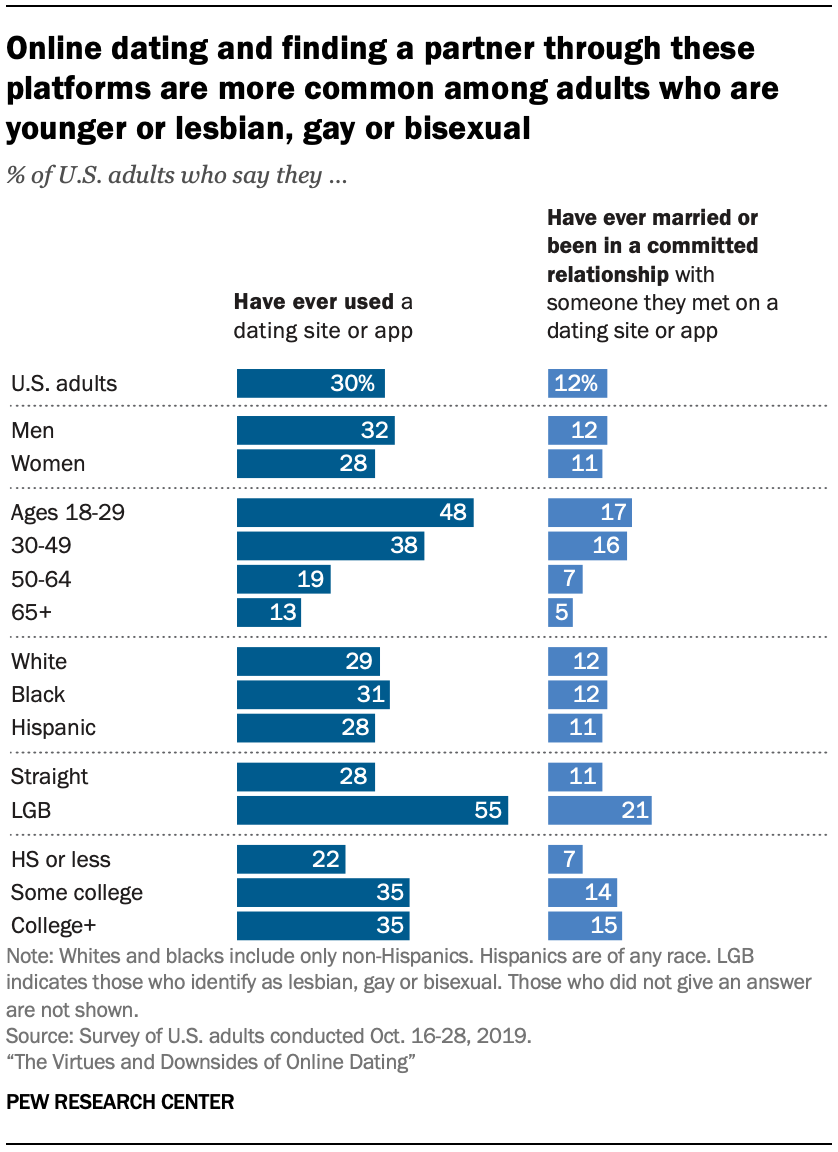
Some 30% of Americans say they have ever used an online dating site or app. Out of those who have used these platforms, 18% say they are currently using them, while an additional 17% say they are not currently doing so but have used them in the past year.
Experience with online dating varies substantially by age. While 48% of 18- to 29-year-olds say they have ever used a dating site or app, that share is 38% among 30- to 49-year-olds, and it is even smaller among those ages 50 and older. Still, online dating is not completely foreign to those in their 50s or early 60s: 19% of adults ages 50 to 64 say they have used a dating site or app.
Beyond age, there also are striking differences by sexual orientation.3 LGB adults are about twice as likely as straight adults to say they have used a dating site or app (55% vs. 28%).4 And in a pattern consistent with previous Pew Research Center surveys, college graduates and those with some college experience are more likely than those with a high school education or less to say they’ve ever online dated.
There are only modest differences between men and women in their use of dating sites or apps, while white, black or Hispanic adults all are equally likely to say they have ever used these platforms.
At the same time, a small share of U.S. adults report that they found a significant other through online dating platforms. Some 12% of adults say they have married or entered into a committed relationship with someone they first met through a dating site or app. This too follows a pattern similar to that seen in overall use, with adults under the age of 50, those who are LGB or who have higher levels of educational attainment more likely to report finding a spouse or committed partner through these platforms.
A majority of online daters say they found it at least somewhat easy to come across others on dating sites or apps that they were physically attracted to or shared their interests

Online dating users are more likely to describe their overall experience with using dating sites or apps in positive, rather than negative, terms. Some 57% of Americans who have ever used a dating site or app say their own personal experiences with these platforms have been very or somewhat positive. Still, about four-in-ten online daters (42%) describe their personal experience with dating sites or apps as at least somewhat negative.
For the most part, different demographic groups tend to view their online dating experiences similarly. But there are some notable exceptions. College-educated online daters, for example, are far more likely than those with a high school diploma or less to say that their own personal experience with dating sites or apps is very or somewhat positive (63% vs. 47%).
At the same time, 71% of online daters report that it was at least somewhat easy to find people on dating sites or apps that they found physically attractive, while about two-thirds say it was easy to find people who shared their hobbies or interests or seemed like someone they would want to meet in person.
While majorities across various demographic groups are more likely to describe their searches as easy, rather than difficult, there are some differences by gender. Among online daters, women are more likely than men to say it was at least somewhat difficult to find people they were physically attracted to (36% vs. 21%), while men were more likely than women to express that it was difficult to find others who shared their hobbies and interests (41% vs. 30%).
Men who have online dated in the past five years are more likely than women to feel as if they did not get enough messages from other users

When asked if they received too many, not enough or just about the right amount of messages on dating sites or apps, 43% of Americans who online dated in the past five years say they did not receive enough messages, while 17% say they received too many messages. Another 40% think the amount of messages they received was just about right.
There are substantial gender differences in the amount of attention online daters say they received on dating sites or apps. Men who have online dated in the past five years are far more likely than women to feel as if they did not get enough messages (57% vs. 24%). On the other hand, women who have online dated in this time period are five times as likely as men to think they were sent too many messages (30% vs. 6%).
The survey also asked online daters about their experiences with getting messages from people they were interested in. In a similar pattern, these users are more likely to report receiving too few rather than too many of these messages (54% vs. 13%). And while gender differences remain, they are far less pronounced. For example, 61% of men who have online dated in the past five years say they did not receive enough messages from people they were interested in, compared with 44% of women who say this.
Roughly seven-in-ten online daters think people lying to appear more desirable is a very common occurrence on online dating platforms
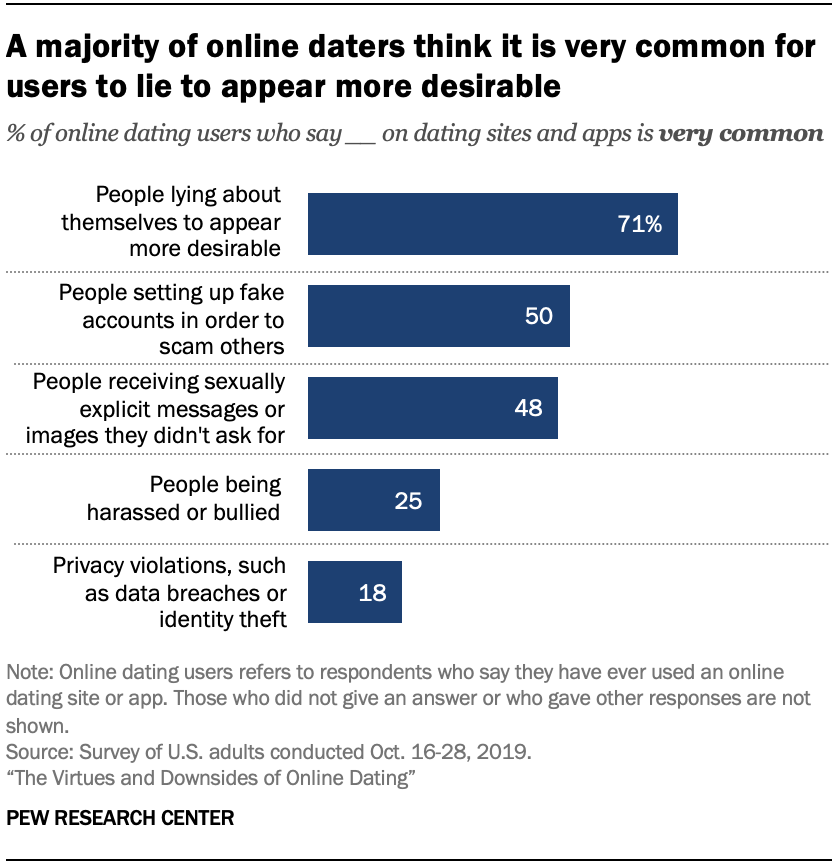
Online daters widely believe that dishonesty is a pervasive issue on these platforms. A clear majority of online daters (71%) say it is very common for people on these platforms to lie about themselves to appear more desirable, while another 25% think it is somewhat common. Only 3% of online daters think this is not a common occurrence on dating platforms.
Smaller, but still substantial shares, of online daters believe people setting up fake accounts in order to scam others (50%) or people receiving sexually explicit messages or images they did not ask for (48%) are very common on dating sites and apps. By contrast, online daters are less likely to think harassment or bullying, and privacy violations, such as data breaches or identify theft, are very common occurrences on these platforms.
Some users – especially younger women – report being the target of rude or harassing behavior while on these platforms
Some experts contend that the open nature of online dating — that is, the fact that many users are strangers to one another — has created a less civil dating environment and therefore makes it difficult to hold people accountable for their behavior. This survey finds that a notable share of online daters have been subjected to some form of harassment measured in this survey.
Roughly three-in-ten or more online dating users say someone through a dating site or app continued to contact them after they said they were not interested (37%), sent them a sexually explicit message or image they didn’t ask for (35%) or called them an offensive name (28%). Fewer online daters say someone via a dating site or app has threatened to physically harm them.
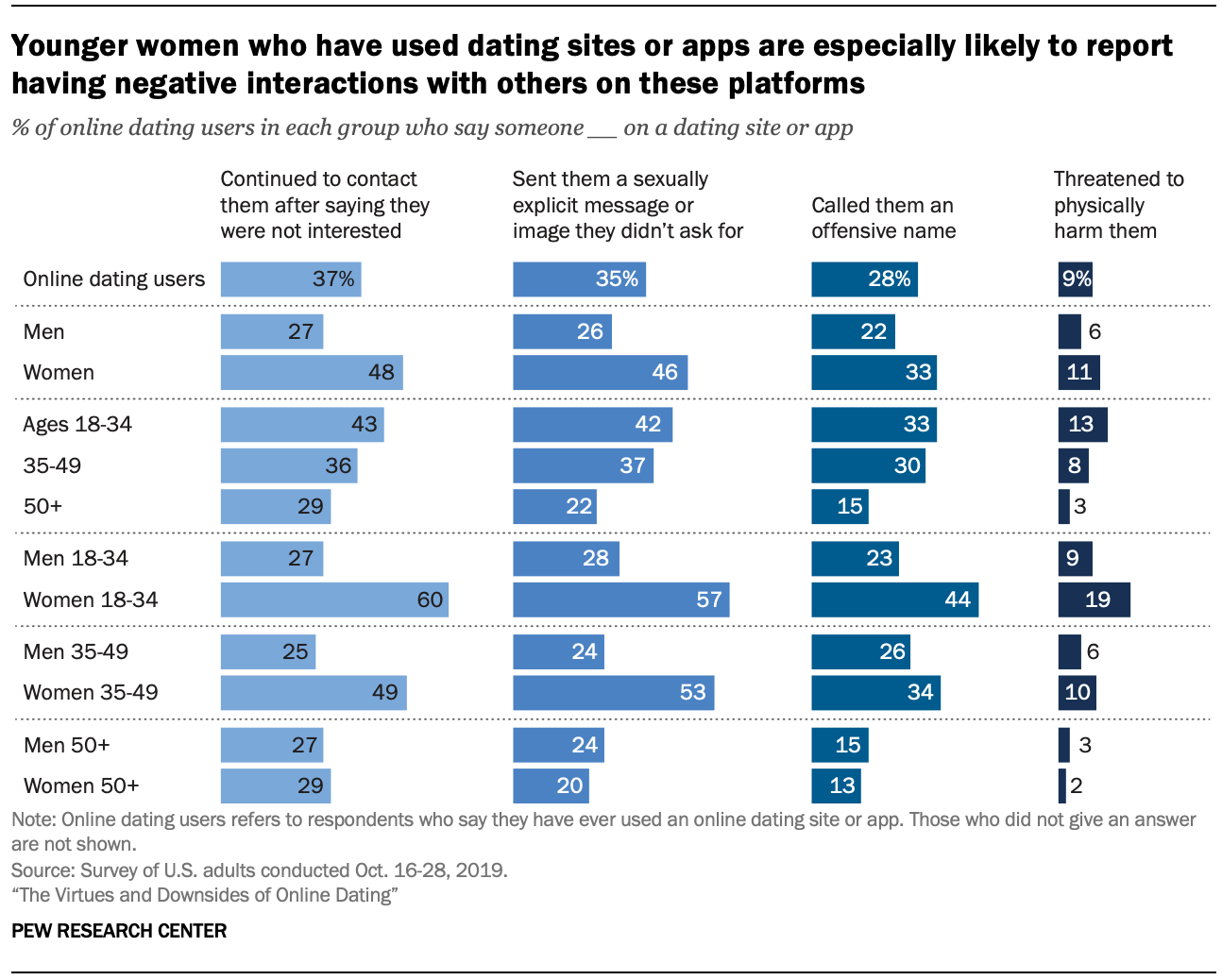
Younger women are particularly likely to encounter each of these behaviors. Six-in-ten female online dating users ages 18 to 34 say someone via a dating site or app continued to contact them after they said they were not interested, while 57% report that another user has sent them a sexually explicit message or image they didn’t ask for. Other negative interactions are more violent in nature: 19% of younger female users say someone on a dating site or app has threatened to physically harm them – roughly twice the rate of men in the same age range who say this.
The likelihood of encountering these kinds of behaviors on dating platforms also varies by sexual orientation. Fully 56% of LGB users say someone on a dating site or app has sent them a sexually explicit message or image they didn’t ask for, compared with about one-third of straight users (32%). LGB users are also more likely than straight users to say someone on a dating site or app continued to contact them after they told them they were not interested, called them an offensive name or threatened to physically harm them.
Online dating is not universally seen as a safe way to meet someone
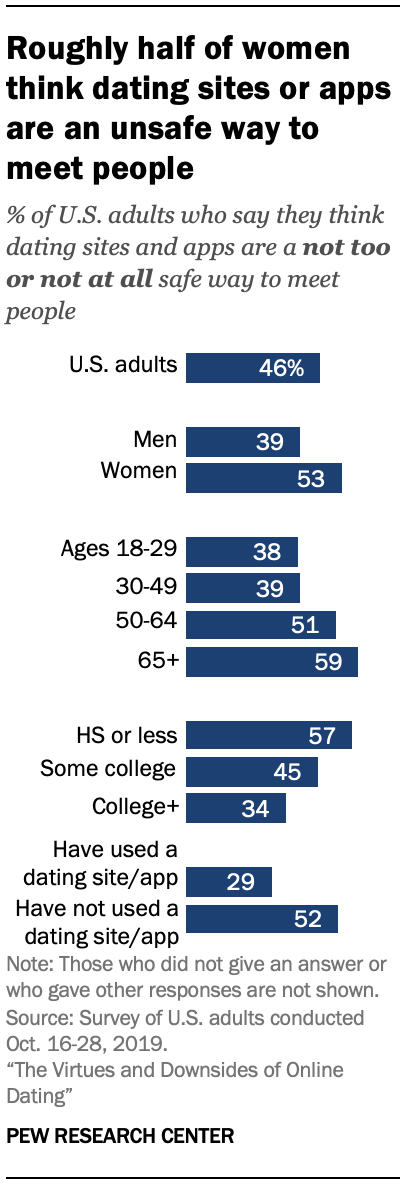
The creators of online dating sites and apps have at times struggled with the perception that these sites could facilitate troubling – or even dangerous – encounters. And although there is some evidence that much of the stigma surrounding these sites has diminished over time, close to half of Americans still find the prospect of meeting someone through a dating site unsafe.
Some 53% of Americans overall (including those who have and have not online dated) agree that dating sites and apps are a very or somewhat safe way to meet people, while a somewhat smaller share (46%) believe these platforms are a not too or not at all safe way of meeting people.
Americans who have never used a dating site or app are particularly skeptical about the safety of online dating. Roughly half of adults who have never used a dating or app (52%) believe that these platforms are a not too or not at all safe way to meet others, compared with 29% of those who have online dated.
There are some groups who are particularly wary of the idea of meeting someone through dating platforms. Women are more inclined than men to believe that dating sites and apps are not a safe way to meet someone (53% vs. 39%).
Age and education are also linked to differing attitudes about the topic. For example, 59% of Americans ages 65 and older say meeting someone this way is not safe, compared with 51% of those ages 50 to 64 and 39% among adults under the age of 50. Those who have a high school education or less are especially likely to say that dating sites and apps are not a safe way to meet people, compared with those who have some college experience or who have at bachelor’s or advanced degree. These patterns are consistent regardless of each group’s own personal experience with using dating sites or apps.
Pluralities think online dating has neither helped nor harmed dating and relationships and that relationships that start online are just as successful as those that begin offline
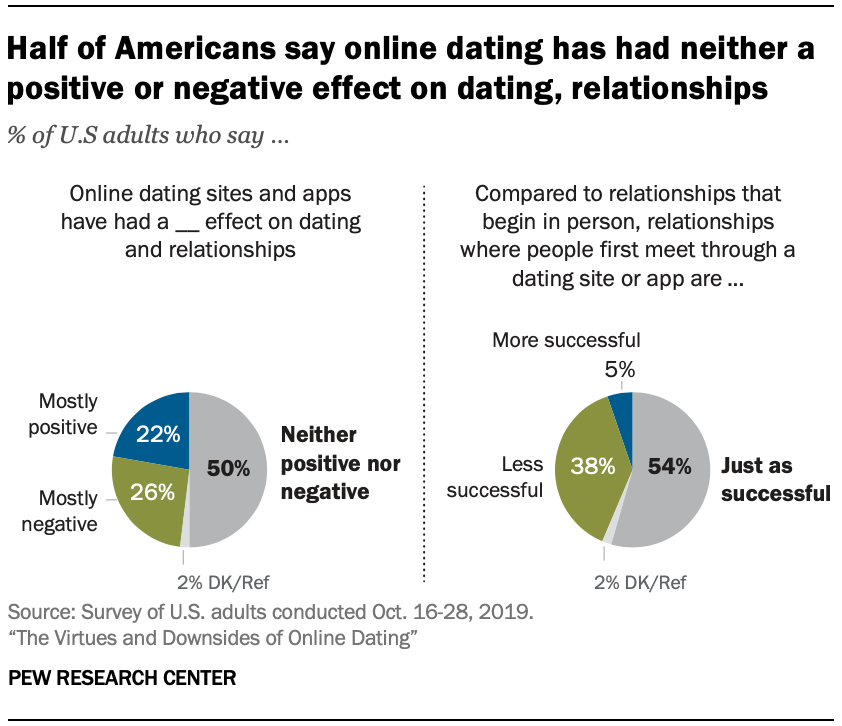
Americans – regardless of whether they have personally used online dating services or not – also weighed in on the virtues and pitfalls of online dating. Some 22% of Americans say online dating sites and apps have had a mostly positive effect on dating and relationships, while a similar proportion (26%) believe their effect has been mostly negative. Still, the largest share of adults – 50% – say online dating has had neither a positive nor negative effect on dating and relationships.
Respondents who say online dating’s effect has been mostly positive or mostly negative were asked to explain in their own words why they felt this way. Some of the most common reasons provided by those who believe online dating has had a positive effect focus on its ability to expand people’s dating pools and to allow people to evaluate someone before agreeing to meet in person. These users also believe dating sites and apps generally make the process of dating easier. On the other hand, people who said online dating has had a mostly negative effect most commonly cite dishonesty and the idea that users misrepresent themselves.
Pluralities also believe that whether a couple met online or in person has little effect on the success of their relationship. Just over half of Americans (54%) say that relationships where couples meet through a dating site or app are just as successful as those that begin in person, 38% believe these relationships are less successful, while 5% deem them more successful.
Public attitudes about the impact or success of online dating differ between those who have used dating platforms and those who have not. While 29% of online dating users say dating sites and apps have had a mostly positive effect on dating and relationships, that share is 21% among non-users. People who have ever used a dating site or app also have a more positive assessment of relationships forged online. Some 62% of online daters believe relationships where people first met through a dating site or app are just as successful as those that began in person, compared with 52% of those who never online dated.




